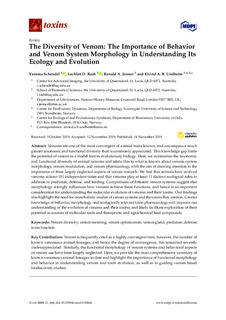| dc.contributor.author | Schendel, Vanessa | |
| dc.contributor.author | Rash, Lachlan D. | |
| dc.contributor.author | Jenner, Ronald A. | |
| dc.contributor.author | Undheim, Eivind Andreas Baste | |
| dc.date.accessioned | 2020-02-18T09:17:47Z | |
| dc.date.available | 2020-02-18T09:17:47Z | |
| dc.date.created | 2019-12-03T14:21:51Z | |
| dc.date.issued | 2019 | |
| dc.identifier.citation | Toxins. 2019, 11 (11), 1-22. | nb_NO |
| dc.identifier.issn | 2072-6651 | |
| dc.identifier.uri | http://hdl.handle.net/11250/2642170 | |
| dc.description.abstract | Venoms are one of the most convergent of animal traits known, and encompass a much greater taxonomic and functional diversity than is commonly appreciated. This knowledge gap limits the potential of venom as a model trait in evolutionary biology. Here, we summarize the taxonomic and functional diversity of animal venoms and relate this to what is known about venom system morphology, venom modulation, and venom pharmacology, with the aim of drawing attention to the importance of these largely neglected aspects of venom research. We find that animals have evolved venoms at least 101 independent times and that venoms play at least 11 distinct ecological roles in addition to predation, defense, and feeding. Comparisons of different venom systems suggest that morphology strongly influences how venoms achieve these functions, and hence is an important consideration for understanding the molecular evolution of venoms and their toxins. Our findings also highlight the need for more holistic studies of venom systems and the toxins they contain. Greater knowledge of behavior, morphology, and ecologically relevant toxin pharmacology will improve our understanding of the evolution of venoms and their toxins, and likely facilitate exploration of their potential as sources of molecular tools and therapeutic and agrochemical lead compounds. | nb_NO |
| dc.language.iso | eng | nb_NO |
| dc.publisher | MDPI | nb_NO |
| dc.rights | Navngivelse 4.0 Internasjonal | * |
| dc.rights.uri | http://creativecommons.org/licenses/by/4.0/deed.no | * |
| dc.title | The diversity of venom: The importance of behavior and venom system morphology in understanding its ecology and evolution | nb_NO |
| dc.type | Journal article | nb_NO |
| dc.type | Peer reviewed | nb_NO |
| dc.description.version | publishedVersion | nb_NO |
| dc.source.pagenumber | 1-22 | nb_NO |
| dc.source.volume | 11 | nb_NO |
| dc.source.journal | Toxins | nb_NO |
| dc.source.issue | 11 | nb_NO |
| dc.identifier.doi | 10.3390/toxins11110666 | |
| dc.identifier.cristin | 1756125 | |
| dc.relation.project | Norges forskningsråd: 287462 | nb_NO |
| dc.description.localcode | ©2019 by the authors. Licensee MDPI, Basel, Switzerland. This article is an open accessarticle distributed under the terms and conditions of the Creative Commons Attribution(CC BY) license (http://creativecommons.org/licenses/by/4.0/). | nb_NO |
| cristin.unitcode | 194,66,10,0 | |
| cristin.unitname | Institutt for biologi | |
| cristin.ispublished | true | |
| cristin.fulltext | original | |
| cristin.qualitycode | 1 | |

